Theatre, as an art form, flourishes through the interplay of creativity and expression. This is where improvisation and storytelling intersect, creating a dynamic synergy that captivates audiences and pushes the boundaries of theatrical innovation. In this comprehensive discussion, we delve into the connections, techniques, and significance of improvisation in the context of storytelling in theatre. Understanding the basics of improvisational theatre and its impact on the craft is essential to appreciating its role in the realm of theatrical performance.
Basics of Improvisational Theatre
Improvisational theatre, often referred to as improv, is a form of live theatre in which the plot, characters, and dialogue of a play are created spontaneously by the performers. It is characterized by its unscripted nature and demands quick thinking, creativity, and teamwork. Improv heavily relies on the performers' ability to effectively communicate, listen, and react in the moment, creating a unique and captivating experience for both the performers and the audience.
The Significance of Improvisation in Theatre
Improvisation serves as a powerful tool in the theatrical world, offering versatility and immediacy to performances. It enables actors to think on their feet, adapt to unexpected situations, and breathe life into characters and narratives. The organic nature of improvisation infuses energy and spontaneity into the theatre, engaging spectators in an experience that is truly one-of-a-kind. Furthermore, improvisation fosters a sense of collaboration, trust, and risk-taking among performers, paving the way for innovative storytelling possibilities.
Exploring the Connection Between Improvisation and Storytelling
Storytelling lies at the heart of theatre, serving as a means to cultivate empathy, provoke thought, and elicit emotional responses. The synergy between improvisation and storytelling is evident in the way improvisational techniques enhance the narrative structure and character development. Through improvisation, performers embody their characters with authenticity and fluidity, bringing depth and immediacy to the storytelling process. The spontaneity and unpredictability of improvisation infuse narratives with vitality, allowing for fresh interpretations and nuanced performances that resonate with audiences.
Techniques of Incorporating Improvisation in Storytelling
There are various techniques through which improvisation is seamlessly integrated into storytelling in theatre. One such technique is 'improv games,' which are structured activities that challenge performers to think creatively and spontaneously. These games encourage actors to explore different narrative scenarios, establish relationships between characters, and construct compelling dialogue on the spot. Additionally, the use of improvisation as a rehearsal tool allows performers to experiment with different approaches, refine character motivations, and uncover hidden layers within the story, thereby enriching the overall theatrical experience. Embracing improvisation as a storytelling device empowers performers to cultivate authenticity, react truthfully in the moment, and contribute to a rich and dynamic narrative tapestry.
The Impact of Improvisational Theatre on Audience Engagement
Improvisational theatre holds the unique ability to captivate audiences through its immersive and interactive nature. By inviting spectators into the spontaneous world of storytelling, improvisation transcends the traditional boundaries between performers and audience, fostering a shared experience that is electric and transformative. The palpable energy and genuine exchanges that arise from improvisation resonate with viewers, creating a sense of immediacy and connection that lingers long after the performance concludes.
Conclusion
Ultimately, the symbiotic relationship between improvisation and storytelling infuses theatre with vitality, authenticity, and boundless creative potential. By embracing the basics of improvisational theatre and recognizing its profound significance in the theatrical landscape, performers can unlock new avenues for narrative exploration and audience engagement. The seamless integration of improvisation into storytelling not only elevates the art of theatre but also strengthens the emotional resonance of the theatrical experience, making it an indispensable component of the dramatic arts.




























